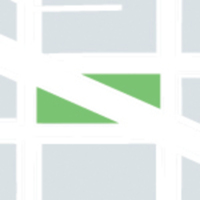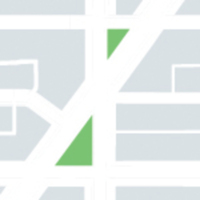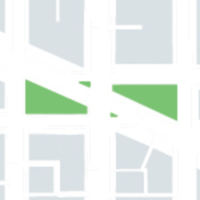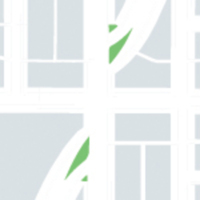Monumentality in Microcosm
| "COMMUNICATING" TRIANGLES |

Reservations 28 and 29, NW (Abad Ocubillo 2012)

Reservations 144 and 145,NW (Abad Ocubillo 2012)

Reservations 68 and 69, NW (Abad Ocubillo 2012)

Reservations 682 and 683, NW (Abad Ocubillo 2012)
The highly rational and geometric pattern of the L'Enfant (and later Ellicott) Street Plans often creates pairs of Triangle Parks from a single open space in the city, such as the Gompers-Burke Parks (Reservations 28 and 29)above.
'Communicating' triangles occur when road intersections create pairs of reservations that, in plan view, mirror one another. The geomoetry of streets can create sets of opposing triangles on opposites sides of an intersection. These can be symmetrical (Reservations 682 & 683) or assymetrical (Reservations 150 & 150A, below). ‘Communicating’ typologies further break down into ‘Symmetrical’ and ‘Asymmetrical’ compositions.
The ‘Square-Triangle’ typology, discussed previously, often creates ‘Symmetrical Communicating’ groups. Other situations in the street plan of Washington, D.C. create numerous ‘Symmetrical Communicating’ groups. The NPS signage posted at Reservation 72 refers to this grouping of reservations as a “Bowtie” park for the way the streets split and stagger the parks into a distinct figural arrangement. Other numerous examples of the ‘Symmetrical Communicating,’ “Bowtie” occur throughout the District.
‘Asymmetrical Communicating’ triangle parks occur more frequently than their symmetrical counterparts. Though the L’Enfant plan endeavored to organize the city with rational symmetry, its execution rendered a great diversity of geometrical permutations of triangle parks at intersections. Excellent examples of ‘Asymmetrical Communicating’ triangle parks occur at Reservations 268-269 (Tennessee Avenue and 14th Street, NE); Reservations 92-92 (Massachusetts Avenue and C Street, SE); and Reservations 144-145 (New Hampshire and 17th Streets, NW).
